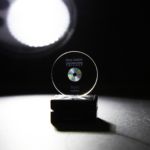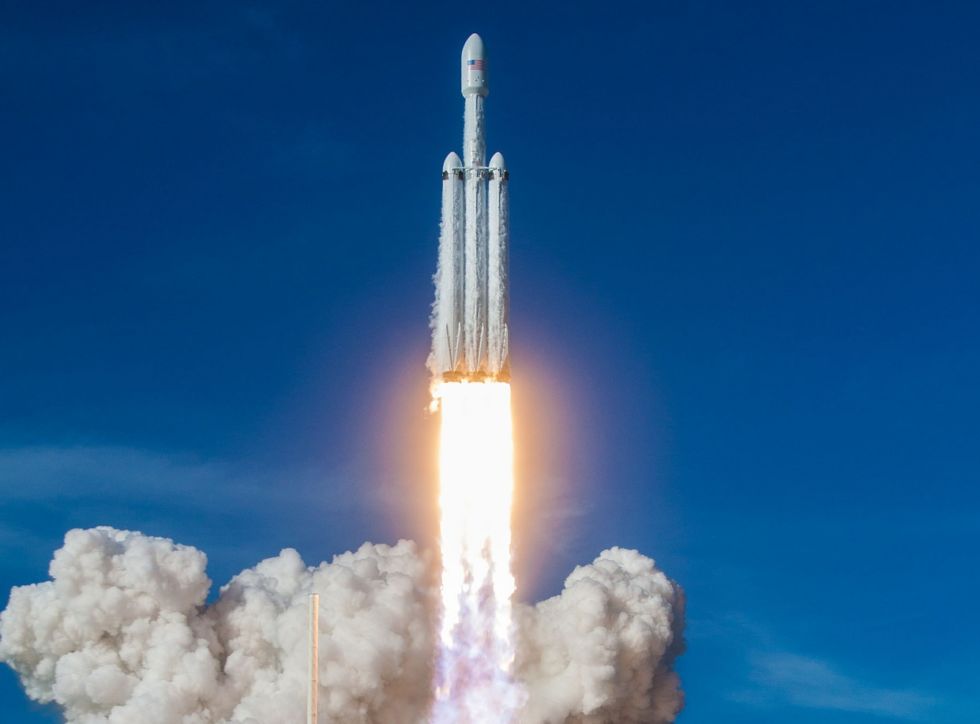You are using an out of date browser. It may not display this or other websites correctly.
You should upgrade or use an alternative browser.
You should upgrade or use an alternative browser.
- Joined
- Apr 1, 2005
- Messages
- 10,307
- Reaction score
- 6,260
The "DON'T PANIC" is a nice touch.
Tip of the hat to Asimov too:
Roadster's secret cargo: a tiny optical disc, known as an Arch (pronounced "ark"). Theoretically, this format of disc can hold 360TB, and the one aboard the launched car contains Asimov's Foundation book trilogy.
Unlike traditional optical discs, according to the Arch Mission’s press release, this Arch disc is "written by a femtosecond laser on quartz silica glass" and its data is "encoded digitally as 20nm gratings, formed by plasma disruptions from the laser pulses."


"Each dot encodes 8 bits in 5 dimensions of light," the group states. "Theoretical capacity is 360TB per disk, and the Archs are stable for 14B+ years. No other medium offers this kind of data capacity and durability."
However, the ambitious group was not immediately able to explain exactly how this data could be read by other humans who don't have specialized hardware to access the data, much less alien civilizations in the future.
- Joined
- May 17, 2005
- Messages
- 12,134
- Reaction score
- 2,626
Hopefully in a few billion years the patents will have expired and anyone with the expertise will have the right to decode the disc.However, the ambitious group was not immediately able to explain exactly how this data could be read by other humans who don't have specialized hardware to access the data, much less alien civilizations in the future.
Just had an idea for a sci-fi story about a team of scientists that record an alien transmission and after years of decoding it find that it is a message claiming that it is both a patent and copyright violation to decode the message and the act of decoding it is an agreement to the license terms that you agree to have the case against you filed in the court of Betelgeuse 5 and you agree that you are pre-guilty of the offence and the penalty is confiscation of your planet!!
Idea for another sci-fi story, in which a large colony ship, a few hundred years in the future, humanity's one, last desperate attempt to escape the environmental devastation on earth is destroyed by a hitherto unknown metal object, which the last living human on-board (or anywhere else) finally figures out, is the remains of an early 21st Century electric roadster. He finds an old fashioned computer memory card and is able to decipher and play over the ships intercom, David Bowie's "Starman" - and as the damage sustained by the reactors in the collision finally causes them to go critical, we are treated to that emotionally delivered lyric telling us that the starman would "like to come and meet as but he thinks he'd blow our minds" as the ship evaporates in a silent blaze of light.
- Joined
- May 17, 2005
- Messages
- 12,134
- Reaction score
- 2,626
Still can't believe that he sends up an electric car, but only enough battery power to run the cameras and telemetry for 12 hours. I was hoping to be able to follow the car at least until the earth was a little marble hanging in the blackness.I think this is about four hours of Car In Space
I know he was burning through propellant to maintain the proper attitude to keep the earth in the shot but maybe next time he can just gimbal the damn cameras!!!
- Joined
- Mar 31, 2005
- Messages
- 7,598
- Reaction score
- 2,544
Still can't believe that he sends up an electric car, but only enough battery power to run the cameras and telemetry for 12 hours. I was hoping to be able to follow the car at least until the earth was a little marble hanging in the blackness.
I know he was burning through propellant to maintain the proper attitude to keep the earth in the shot but maybe next time he can just gimbal the damn cameras!!!
I think it's a very cool idea, but next time can he JUST give ME the car and I'll drive it around on Earth

- Joined
- Mar 31, 2005
- Messages
- 7,598
- Reaction score
- 2,544
Tip of the hat to Asimov too:
Roadster's secret cargo: a tiny optical disc, known as an Arch (pronounced "ark"). Theoretically, this format of disc can hold 360TB, and the one aboard the launched car contains Asimov's Foundation book trilogy.
Unlike traditional optical discs, according to the Arch Mission’s press release, this Arch disc is "written by a femtosecond laser on quartz silica glass" and its data is "encoded digitally as 20nm gratings, formed by plasma disruptions from the laser pulses."
"Each dot encodes 8 bits in 5 dimensions of light," the group states. "Theoretical capacity is 360TB per disk, and the Archs are stable for 14B+ years. No other medium offers this kind of data capacity and durability."
However, the ambitious group was not immediately able to explain exactly how this data could be read by other humans who don't have specialized hardware to access the data, much less alien civilizations in the future.
AND they are so cute and tiny

- Joined
- Apr 2, 2005
- Messages
- 14,036
- Reaction score
- 2,041
Still can't believe that he sends up an electric car, but only enough battery power to run the cameras and telemetry for 12 hours. I was hoping to be able to follow the car at least until the earth was a little marble hanging in the blackness.
I know he was burning through propellant to maintain the proper attitude to keep the earth in the shot but maybe next time he can just gimbal the damn cameras!!!
Over on Fakebook I was asking a Liberal friend about the carbon footprint of Musk's vanity project but was laughed at. The whole "he needed a payload" is bunk anyhow. He could have sent solidified CO2 rock into space. Seems Musk's version or environmentalism is the same as Al Gore's.
As for the vanity project itself? I fall into the camp of it being nothing more than space junk.
Besides, he wasn't the first. ZZ Top should sue ;-)
- Joined
- May 17, 2005
- Messages
- 12,134
- Reaction score
- 2,626
Over on Fakebook I was asking a Liberal friend about the carbon footprint of Musk's vanity project but was laughed at. The whole "he needed a payload" is bunk anyhow. He could have sent solidified CO2 rock into space. Seems Musk's version or environmentalism is the same as Al Gore's.
From here:
https://www.eia.gov/totalenergy/dat...02.05#/?f=A&start=1949&end=2016&charted=3-4-7
US energy use for transportation is about 27 petaBTU or 27*10^15 BTU per year
From here:
https://en.wikipedia.org/wiki/Gasoline_gallon_equivalent
114,000 BTU is equivalent to 1 gallon of gasoline
According to:
http://www.spacelaunchreport.com/falconH.html
The fuel load is
~407.6 tonnes per booster
~407.6 tonnes for the core
~107.2 tonnes for stage 2
which is 3 * 407.6 + 107.2 = 1330 tonnes of kerosene which is chemically/energetically similar to gasoline.
Kerosene and gasoline are both about 3.4 tonnes per 1000gal(US)
so fuel load for Falcon is about 391,000 gallons (US)
US transportation gasoline use is 27*10^15 BTU / 114000BTU/gal is 228070175438596491 gallons per year or 624849795722182 gallons/day
so the Falcon launch was about 391000*100/624849795722182 % or 0.00000006% of the daily use of gasoline for transportation in the US. Gives you some rough idea of the emissions.
As for the full carbon footprint of the project (including manufacture of the rockets which he tries to reuse, thus reducing the footprint per launch) is mostly governed by the footprint of the people working on the project. It'll certainly be a tiny fraction of even just the US military's footprint.
- Joined
- Apr 2, 2005
- Messages
- 14,036
- Reaction score
- 2,041
From here:
https://www.eia.gov/totalenergy/dat...02.05#/?f=A&start=1949&end=2016&charted=3-4-7
US energy use for transportation is about 27 petaBTU or 27*10^15 BTU per year
From here:
https://en.wikipedia.org/wiki/Gasoline_gallon_equivalent
114,000 BTU is equivalent to 1 gallon of gasoline
According to:
http://www.spacelaunchreport.com/falconH.html
The fuel load is
~407.6 tonnes per booster
~407.6 tonnes for the core
~107.2 tonnes for stage 2
which is 3 * 407.6 + 107.2 = 1330 tonnes of kerosene which is chemically/energetically similar to gasoline.
Kerosene and gasoline are both about 3.4 tonnes per 1000gal(US)
so fuel load for Falcon is about 391,000 gallons (US)
US transportation gasoline use is 27*10^15 BTU / 114000BTU/gal is 228070175438596491 gallons per year or 624849795722182 gallons/day
so the Falcon launch was about 391000*100/624849795722182 % or 0.00000006% of the daily use of gasoline for transportation in the US. Gives you some rough idea of the emissions.
As for the full carbon footprint of the project (including manufacture of the rockets which he tries to reuse, thus reducing the footprint per launch) is mostly governed by the footprint of the people working on the project. It'll certainly be a tiny fraction of even just the US military's footprint.
You are only talking about the fuel for the rocket, not the car itself that became space junk.
Tesla car battery production releases as much CO2 as 8 years of gasoline driving
Huge hopes have been tied to electric cars as the solution to automotive CO2 climate problem. But it turns out the the electric car batteries are eco-villains in the production process of creating them. Several tons of carbon dioxide has been emitted, even before the batteries leave the factory.
IVL Swedish Environmental Research Institute was commissioned by the Swedish Transport Administration and the Swedish Energy Agency to investigate litium-ion batteries climate impact from a life cycle perspective. There are batteries designed for electric vehicles included in the study. The two authors Lisbeth Dahllöf and Mia Romare has done a meta-study that is reviewed and compiled existing studies.
The report shows that the battery manufacturing leads to high emissions. For every kilowatt hour of storage capacity in the battery generated emissions of 150 to 200 kilos of carbon dioxide already in the factory. The researchers did not study individual brand batteries, how these were produced, or the electricity mix they use. But if we understand the great importance of the battery here is an example: Two common electric cars on the market, the Nissan Leaf and the Tesla Model S, the batteries about 30 kWh and 100 kWh.
Even before buying the car emissions occurred, corresponding to approximately 5.3 tons and 17.5 tons of Carbon Dioxide. The numbers can be difficult to relate to. As a comparison, a trip for one person round trip from Stockholm to New York by air causes the release of more than 600 kilograms of carbon dioxide, according to the UN organization ICAO calculation.
- Joined
- May 17, 2005
- Messages
- 12,134
- Reaction score
- 2,626
The actual report can be found here. It's in English. It's quite long, but interesting. It talks about where those costs come from and how they may be mitigated in the future. Currently lithium battery recycling is almost non-existent, for one. Everywhere there is CO2 there is an economic cost and so cost reduction will see automatic improvements in footprint. Then, the energy source for manufacturing is also a big factor. The cleaner the power source for the factories, the less the CO2 footprint.You are only talking about the fuel for the rocket, not the car itself that became space junk.
Tesla car battery production releases as much CO2 as 8 years of gasoline driving
Car manufacture in general is not cheap. According to this article, a Ford Mondeo generates 17 tonnes of CO2 in manufacturing. That's roughly what is being claimed for a 100kWh battery. Manufacturing an internal combustion engine and keeping it fed and maintained isn't a zero footprint exercise either.
A Popular Mechanics article points out that the 8 year maths isn't right.
And, as with manufacturing, where you get your electricity makes a big difference in foot print for driving.
- Joined
- May 28, 2011
- Messages
- 352
- Reaction score
- 128
If We Receive a Message From Aliens, Should We Delete It Without Reading?

Yes. Yes we should. No question.

Yes. Yes we should. No question.
- Joined
- Apr 1, 2005
- Messages
- 10,307
- Reaction score
- 6,260
No, probably not.
Even if the intentions of the senders are malevolent, deleting without reading would probably only serve to delay events without giving any insight into this new 'enemy'.
- Joined
- Apr 1, 2005
- Messages
- 10,307
- Reaction score
- 6,260
The 'Vanity Project' is an absurdly low-cost heavy lift rocket
The new SpaceX rocket seriously undercuts its competitors.

Now that SpaceX's new rocket is finally flying, we can directly compare costs between this new booster and an existing rocket in its class, the Delta IV Heavy, as well as NASA's upcoming heavy lift booster, the Space Launch System. And upon direct comparison, the cost disparities are sobering, proving that commercial development of large rockets likely represents the future of the industry.
The new SpaceX rocket seriously undercuts its competitors.

Now that SpaceX's new rocket is finally flying, we can directly compare costs between this new booster and an existing rocket in its class, the Delta IV Heavy, as well as NASA's upcoming heavy lift booster, the Space Launch System. And upon direct comparison, the cost disparities are sobering, proving that commercial development of large rockets likely represents the future of the industry.
- Joined
- Apr 2, 2005
- Messages
- 14,036
- Reaction score
- 2,041
The 'Vanity Project' is an absurdly low-cost heavy lift rocket
The rocket isn't a vanity project, make a Tesla Sports Car into space junk as payload was.
- Joined
- Apr 1, 2005
- Messages
- 10,307
- Reaction score
- 6,260
The rocket isn't a vanity project, make a Tesla Sports Car into space junk as payload was.
True but that payload generated a lot more publicity than a lump of concrete - or CO2 rock - would have.
I initially thought the Tesla was a stupid idea and thought he should have opened it to universities to send up cube sats or some such, given they tend to be cheap (relatively) so the risk of them never getting to orbit wouldn't be as big a deal.
Then I saw it. It looked cool. I changed my mind.

- Joined
- Mar 31, 2005
- Messages
- 10,232
- Reaction score
- 3,006
If We Receive a Message From Aliens, Should We Delete It Without Reading?
Yes. Yes we should. No question.
It's human nature to solve puzzles
Planet Earth has essentially been broadcasting its presence since radio broadcasts began. Considering the vastness of the Universe, if the message came from Proxima Centauri , the latency between messages would be 8.4 years
Considering our experience with the Internet, the message would be either a cat meme , a letter from a long lost Nigerian relative who died and left you billions of credits in a Proxima Centauri bank, or tentacle porn
- Joined
- Mar 31, 2005
- Messages
- 10,232
- Reaction score
- 3,006
Then I saw it. It looked cool. I changed my mind.

Did anyone check the trunk?
- Joined
- Apr 1, 2005
- Messages
- 10,307
- Reaction score
- 6,260
Or who was in the suit?Did anyone check the trunk?

